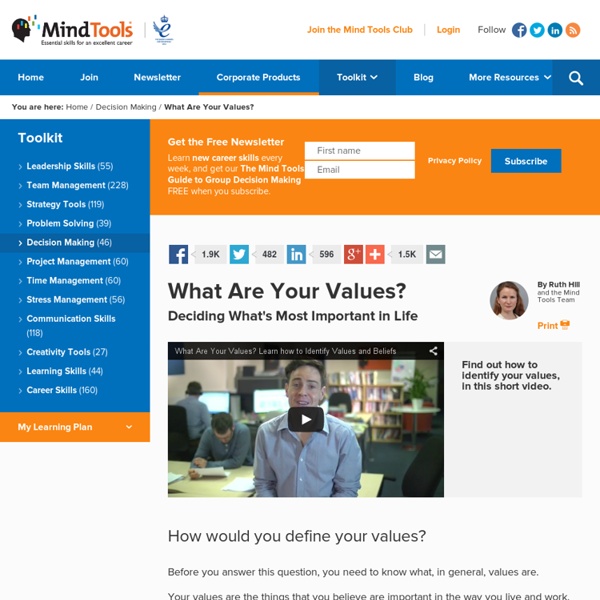Brains, Behavior & Design
These reference cards are helpful when becoming familiar with basic behavioral economics concepts. This tool is by no means a complete or comprehensive collection of all behavioral economics concepts; they are a selection meant to provide enough depth and coverage to help establish a foundation. Terms on the reference cards are categorized into four decision-making factors and four decision-making shortcuts. Each category includes an index card that provides an overview of the category and suggestions for related design strategies. Introduction to Reference Cards All Reference Cards top
How To Open Up People's Minds to Change
How to open up the mind to change and avoid a defensive reaction. A very simple exercise — self-affirmation — can open up people’s minds to behaviour change, a new study finds. When given advice about how to change, people are often automatically defensive, trying to justify their current behaviour. Messages about eating healthier, doing some exercise and all the rest may be rejected by stock defences, like not having enough time or energy. Now, research has found that focusing on values that are personally important — such as helping a family member — can help people act on advice they might otherwise find too threatening. The study, published in the Proceedings of the National Academy of Science, scanned people’s brains as they were given typical advice about exercise you might get from any doctor (Falk et al., 2015). The researchers were interested in activity in part of the brain called the ventromedial prefrontal cortex (VMPFC). Dr Emily Falk, who led the study, said:
Business Origami – The Centre for Citizen Experience
Jess McMullin Business origami is paper prototyping for systems design. It uses simple paper cutouts to represent the different parts of a system: the people, the locations, the channels used and the specific touchpoints where interactions occur and value is exchanged as a particular scenario unfolds. These cutouts are arranged on a horizontal whiteboard, which allows participants to show relationships in the system. Update: August 4, 2011 – It looks like the Hitachi Design Centre team now has a brief page up on their site about business origami (Japanese). Here’s a quick slideshare over view of how the components work together. Business origami works best in a workshop setting, with multiple people from different areas of the system you’re exploring. If you’d like to try this yourself, here’s the Business Origami Shapes PDF. If you’re interested in how business origami could benefit your organization, please get in touch.
Let Your Values Drive Your Choices
Nearly every problem you face is temporary. But these temporary problems cause immediate pain. And we often let this pain drive our choices and actions. For example… An employee suffering from the pain of not feeling important enough or powerful enough might take a terrible job with a fancy title.An individual suffering from the pain of feeling unloved or unappreciated or misunderstood might try to resolve that pain by cheating on their spouse.An entrepreneur suffering from the pain of a faltering small business might resort to using questionable marketing tactics to try to drive more sales. …and so on. This is how you make choices you wouldn’t normally make. How can we avoid this pitfall and make better long-term choices while still resolving short-term pain? Here’s an approach I’ve been trying recently. Let Your Values Drive Your Choices One of the solutions I’ve been trying out is to let my values drive my choices. I can ask, “Is this in alignment with my values?” The Bottom Line
Gamestorming
The 3 Best Questionnaires for Measuring Values
Our values fuel our actions, emotions, and behavior. It is a crucial aspect of significant branches of studies, including sociology, philosophy, education, and psychology. Values are tied in with ethics and morals; they guide our judgment and prepare us to choose actions according to their consequences. The human value system serves self-exploration, self-enhancement, and self-recognition. Psychologists believe in the transformative power of values. Whether personal, professional, social, or life-oriented, values make room for knowledge, wisdom, and heightened self-realization. In this article, we will discuss some of the most popular and standardized measures for evaluating our personal and core values. The Valued Living Questionnaire (VLQ) Values develop from personal experiences, observational learning, and environmental influences. The ten areas include: Some scientists working on Acceptance and Commitment Therapy initially created the Valued Living Questionnaire (VLQ). These are:
LEGO SERIOUS PLAY - BUILD YOUR WAY TO BETTER BUSINESS
Click With Me Now - share the web
7 Resources Every Designer Should Know
It’s essential for designers to stay on top of the ever-growing list of galleries, apps, and tools that can be found. But at this point, there are so many great design resources on hand that sometimes it can be overwhelming to attempt a survey of them. So instead, let’s focus in on the ones that you’ll really find yourself returning to, day after day. For inspiration, we’ve rounded up three resources with completely different scopes and subjects; in combination, they might be all you need to get yourself going on your next project. For tools, we’ve made selections that reach out to all the different design disciplines; whether you work primarily in print or web, alone or in a group, you’ll find a great timesaver or two. Inspiration Get a Broad Scope: Designspiration Although you can browse through images from any creative field, such as architecture and photography, everything in this huge compendium of inspiration can be brought back to great design. Hone UI Details: UI Parade Tools



